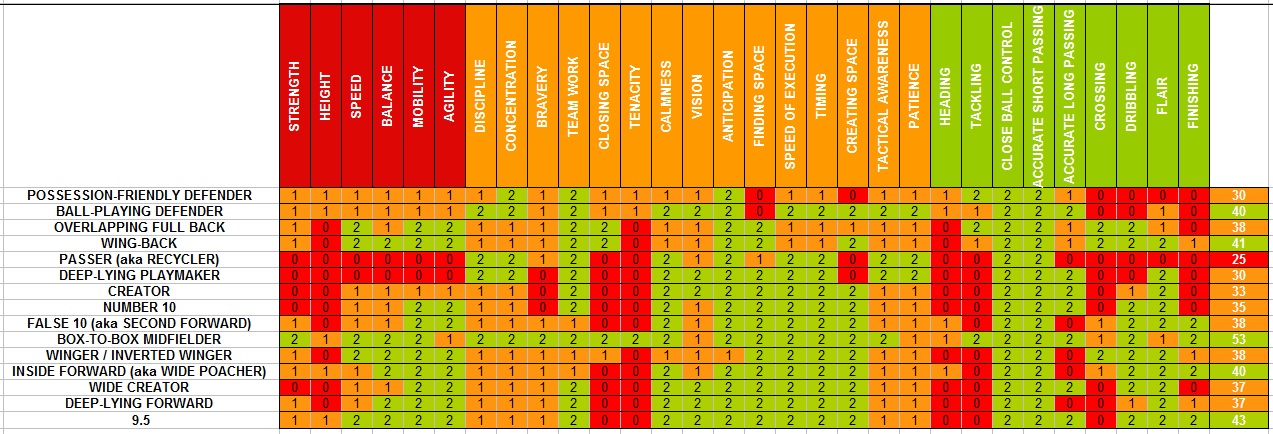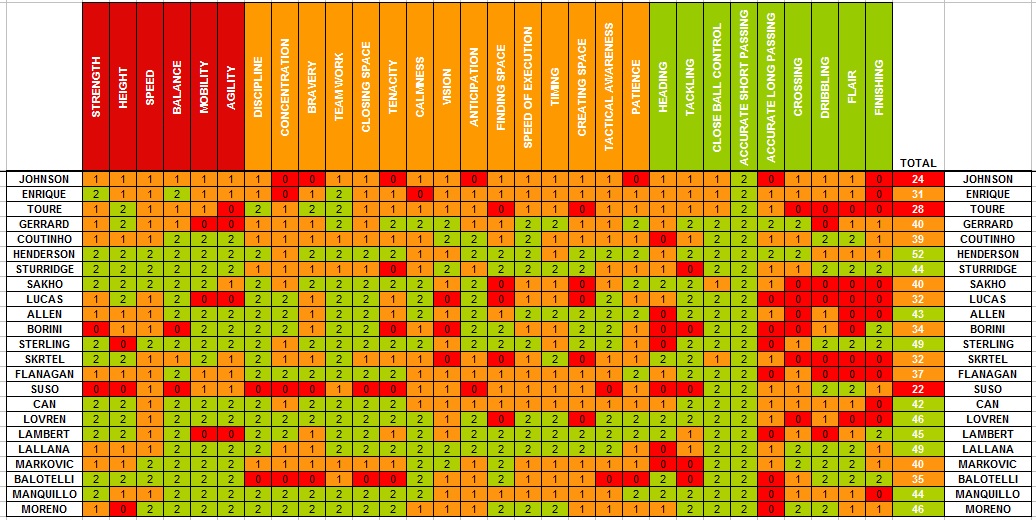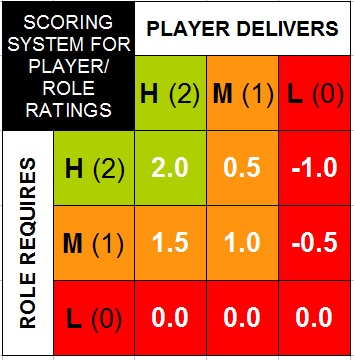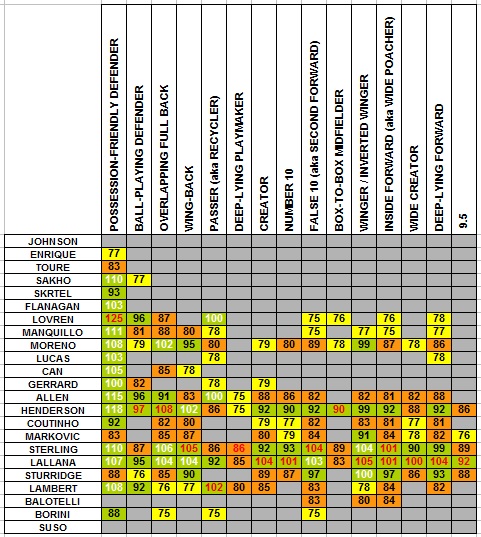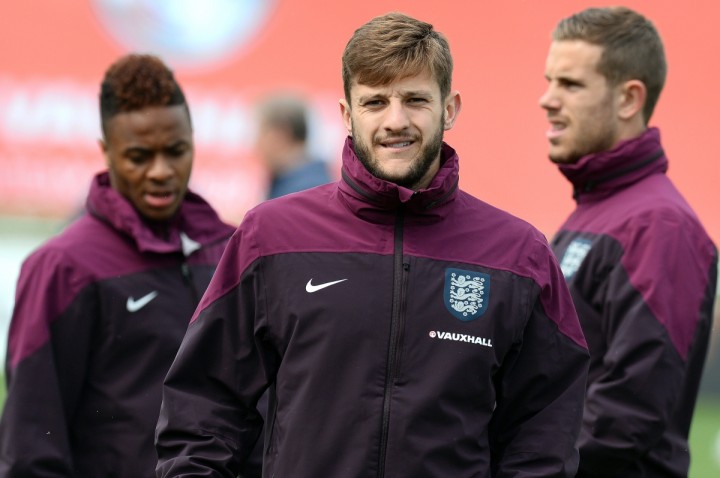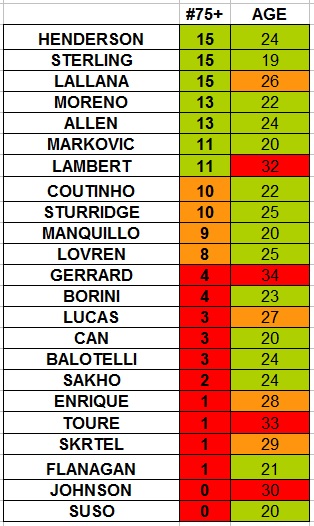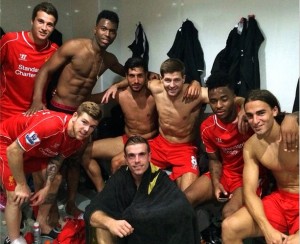By Bob Pearce.
I have previously talked about the idea of an elements model. This had 30 elements grouped into Physical elements (e.g. Strength, Speed, Height, etc.), Mental elements (e.g. Concentration, Vision, Patience, etc.), and Technical elements (e.g. Tackling, Close Ball Control, Accurate Long Passing, etc.) that could be grouped together in a huge variety of combinations, like the ingredients for a multitude of meals.
The idea behind the project was to see if this format could offer two initial opportunities. Firstly, it would be possible to build profiles of the requirements of different roles within the team. This would make it possible to see similarities and differences between the roles, and track and describe any ‘new’ roles as they emerge.
I asked TTT’s tactical guru Mihail Vladimirov to rate each role listed in his Tactical Glossary against each individual element using a scale of High, Medium and Low. Ultimately this is ‘just’ his view. Having said that, it is a view based on his closely studying players from a tactical observer’s point of view over a number of years. Accepting these limitations, the next step was to convert the High, Medium and Low ratings into numbers (2, 1 and 0) to allow calculations to take place and colour them Red, Amber, and Green for visual efficiency.
Some initial observations. When just looking at the number of elements that need to be performed to a High standard, the Box-to-Box Midfielder role towers over the rest. It is the only role which requires all 30 of the elements, with 23 needing to be performed to a High standard.
When looking at the individual elements there are three (Strength, Bravery and Tenacity) that show up as being required at a High level in only one role each. It should be no surprise to find that they are all in the Box-to-Box Midfielder role. It’s safe to say that it is a very rare player that excels in this role, and you’d expect their fee to reflect that scarcity.
It is a long way to the next most demanding roles, which are at 9.5 (43), Wing-Back (41), then Inside Forward and Ball-Playing Defender (both 40).
Playing right alongside the Ball Playing Defender we can find the Possession-Friendly Defender, a role at the other end of the spectrum, which requires the lowest number of High (Green) requirements (6).
The least ‘demanding role’ (i.e. with the lowest level of total requirements) is Passer (aka Recycler) (25), followed by Defender Deep Lying Playmaker and unsurprisingly Possession Friendly Defender (both 30).
In simple terms the most ‘demanding’ role of Box to Box Midfielder (53) could be described as requiring twice as much from a player than the Passer (aka Recycler) role (25).
I said there was a second initial opportunity that the model offers, and that is the profiling of each player’s strengths and weaknesses. This would then make it possible to see the great variety and detail the many differences between players, track an individual’s career arc of development and decline, and be clear about where these changes were happening.
Again, I asked Mihail at the start of the season to rate each player on a scale of High, Medium, and Low against each individual element. Again this is his view, again this is a view based on a number of years of study, and again 0, 1, 2 for calculations and Red, Amber, Green for visual efficiency.
Clearly, while the rating system of High, Medium and Low is a little more nuanced than a simple ‘yes’ or ‘no’ judgement, it is still limited in its subtlety. At this stage this scale is adequate. This is just a model, and the aim is to see if the model works. The sophistication can be layered on if necessary later.
One initial observation about the table worth noting is that Jordan Henderson, the new vice captain, is the only player in the squad without a single Low (Red) rating on any element in his profile.
If we can find a way to let the numbers talk to each other we can listen to their conversation.
When these player profiles are cross-referenced with the role requirements profiles we can expect to clearly see how well suited each player is to each role, with a series of Player/Role Ratings (P/RR)
Calculating a P/RR it is not simply a case of taking the total number from each individual player’s profile and comparing this to to the total number from each role profile. It is important to look at how their ratings match up element by element.
So, if a role does not require a particular element (e.g. Height) then there was no value in the player having that element in their profile. As a result their High score of 2 in that element would be of no value, and so they’d score a 0 against that element in the Player/Role Rating exercise.
Conversely, where the role had a High requirement for a particular element (e.g. Concentration), if the player did not score a High rating on this element in their profile it would actually prove to be a source of serious concern, and this negative factor would be reflected in the score in the Player/Role Rating exercise.
Before we can run every player through the Player/Role Rating exercise and get their scores for each role, there’s one last thing to note. Logically the ideal score would seem to be for the player to achieve a 100% match.
But if the element requirement for a role is 1 and the player profile is 2, they will literally be ‘more than a match’ for the role. Since this has the additional advantage of delivering trust to their colleagues who will not be required to make allowances for them and can therefore focus entirely on their own role, this positive factor is reflected in the score. Logically what this means is that it is possible to achieve a rating of over 100% player/role match. Perhaps you could regard any figure above 100 as the additional trust within the team. Totalled up across the team this may perhaps be a measure of ‘Mr Inbetween’.
This process, which started with the relatively basic ratings of High, Medium and Low for player profiles and role requirements, is now building to provide a relatively sophisticated and nuanced picture of each player’s suitability to each role by providing a percentage ‘fit-ness’ figure.
Before looking at the findings, there are two filters that it makes sense to apply to the results. Clearly most players would get some level of score against every role, so there is a need to set the bar at a suitably high level of potential performance within the role. Alex Inglethorpe, Liverpool’s Academy Director recently said “We are looking to produce Champions League players here.” That is the standard that Liverpool’s first team squad need to be striving for. I’ve introduced an entry level of 75% for a P/RR to be included on the table, then graded scores of 75-80 as Adequate (Yellow), 81-89 as Good (Amber) ,and 90+ as Excellent (Green). In simple terms, for the testing of the model, we could think of a Green 90+ P/RR as Inglethorpe’s “Champions League players”.
The second filter concerns the roles that player profiles were matched against. Based on his tactical observations Mihail believes that this season Rodgers will work within a set number of formation and employ variations within these. The four core formations are 4-1-2-3, 4-1-2-1-2, 4-2-1-3, and 4-2-3-1, so I am therefore only interested in the roles that will be used in these formations – the Rodgers Relevant Roles. So the table below shows players scoring a 75+ Player/Rodgers Relevant Role Rating (P/RRRR).
I’ll pause while you ‘sense check’ that the model is coming close to matching your intuitive perceptions (i.e. would you agree that Skrtel has limitations while Henderson is a ‘Swiss army knife’ of a player?).
If you have a team of ‘specialists’ there are clear limitations. Injury or suspension will remove that ‘specialist’ link in your chain. Poor form will also reduce the effectiveness of your chain.
Having a team with ‘universatility’ addresses both of these problems. With several players able to cover a role to a high standard, when there are injuries, suspensions or dips in form (all of which should realistically be factored into any season), the links can be replaced and the chain can remain strong.
Players will not just need to step into a number of different roles within a season, it will be a requirement within a single game. There is value in versatility, and logically greater versatility value is achieved by those players who have the widest range of elements that they can draw on to deliver the requirements of a greater range of roles.
I’ll cover the bad news first. According to the model, the thinnest cover in the squad is in the role of Deep-Laying Playmaker, where although there are five 75+ players, not one of them has a P/RRRR of 90+ (which I’ve rightly or wrongly introduced as the ‘Champions League’ level).
Now the good news. There is plenty of Green all over the table, meaning there are a number of ‘Champions League’ options available in most roles, which begins to suggest some strength in depth across the squad.
Lallana is the first of three stand out players. At 26 he covers all 15 of the roles that Rodgers can be expected to use at 75+ level. That level of versatility alone is mighty impressive. But when you see that he scores 90+ in 13 of the 15 roles his P/RRRRs are quite stunning. Not only can he perform in any of the outfield roles that Rodgers is likely to use, he will excel at the majority. His lowest scoring role is Box to Box Midfielder where his rating of 83 still makes him third best in the squad. If you were to judge the ‘best’ player in each of the 15 roles by their P/RRRR figure, amazingly there is one player that scores as the ‘best’ in seven of the 15 roles. Lallana. The model makes him look like an outstanding purchase for the £20m fee. Flexibility? Tick. Development needed? Little room left. In a word, ‘Wow!’
The second stand out player is Henderson. Like Lallana he covers all 15 roles that Rodgers can be expected to use at 75+ level. If it were not for Lallana, Henderson’s 90+ rating in 11 of the 15 roles would get the headline. He actually has the highest squad rating in three of the 15 Rodgers Relevant Roles. Flexibility? Tick. Development needed? With a track record of development, at 24 his suitability for his ‘weakest’ role of Deep Lying Midfielder (75) can reasonably be expected to improve too. Look again at Henderson’s player profile rating total of 52. The maximum score achievable against the 30 elements is 60, meaning Henderson is just eight short of ‘perfection’. When you look at those eight elements that he could still improve on, that ‘perfection’ doesn’t seem so unrealistic. Again, he now looks like another outstanding purchase for the £20m fee.
The third stand out player is Sterling. It is quite amazing that he too covers all 15 roles that Rodgers can be expected to use at 75+ level, and yet he is still just 19. That is even more extraordinary when we see that he is rating at 90+ in 10 of those roles. Even in his ‘weakest’ role of Deep Lying Playmaker (86) he still has the highest P/RRRR in the squad. He actually has the highest squad rating in three of the 15 Rodgers Relevant Roles. Flexibility? Tick. Development needed? Again his track record of development shows him hurtling forward. And the best part? Even when his maximum fee of £5m is triggered Sterling will clearly redefine the meaning of the word ‘bargain’.
Between Lallana, Henderson and Sterling they have the highest squad rating in 13 of the 15 Rodgers Relevant Roles. The one worrying thing about that for Rodgers must be that they are all English, and so currently at the mercy of Hodgson’s ‘antique’ methods. That thought must fill him with dread. Inglethorpe talked about a ‘wish list’ of coaches at other clubs they had identified as suitable to develop the players they’d send out out on loan. Hodgson would clearly not be on that ‘wish list’.
Other players worthy of note are Allen and Moreno who both have 75+ ratings in 13 of the 15 Rodgers relevant roles, and 4 each at 90+. Flexibility? Tick. Development needed? At 24 and 22 respectively Rodgers has time to coach them further.
Lambert and Markovic both rated at 75+ in 11 of the 15 Rodgers Relevant Roles. At 20 Markovic has plenty of versatility and with development can add to his one 90+ rating (Winger). Meanwhile Lambert at 32 may surprise many, not just with his three 90+ ratings, but that they are all at the defensive end of the team. It should not then come as a surprise if we ever see Lambert being used here in the future.
Coutinho and Sturridge get a mention for both having 70+ ratings in 10 of the 15 Rodgers Relevant Roles. At 25 Sturridge has five 90+ ratings and can be expected to continue the development we’ve seen already. At 22 Coutinho currently has one 90+ rating, but his general versatility level suggest that with a little further development the best of Coutinho is still to come.
When it comes to Balotelli there are three things to say. Development. Development. Development. A 3D player. That subject is an article all on its own.
One stand-out feature of the results is that of the new signings Lovren, Manquillo, Moreno, Markovic, Lallana, and Lambert all have 75+ scores in more than eight roles.
What do we find when we compare ‘old’ and ‘new’? In terms of a straight comparison between Johnson (30) and Enrique (28) against Manquillo (20) and Moreno (22), the difference is pretty stark. You may have thought that I’d forgotten to include Johnson’s P/RRRR figures, but he actually had no 75+ P/RRRRs, and Enrique just reaches that level for one role. In contrast Manquillo achieves a 75+ P/RRRR in nine roles, and Moreno shows a 75+ P/RRRR in 13. If you were wondering why Kelly was sold to Crystal Palace for £1.5m, perhaps his being rated as 75+ in only one role was the answer.
Lovren (25) is also head and shoulders above the other central defensive candidates. Toure (33) and Skrtel (29) score a 75+ P/RRRR in one role each, with Sakho (24) scoring 75+ in two roles. Lovren’s has a 75+ P/RRRR in eight roles.
If you wanted to ask if Lovren is an impovement on Agger, the numbers show they both score 90+ in the same three roles (Possession Friendly Defender, Ball Playing Defender and Passer (aka Recycler)). But Lovren scores a significantly better P/RRRR for all three roles.
Possession Friendly Defender – Agger = 108/Lovren = 125.
Ball Playing Defender – Agger = 90/Lovren = 96.
Passer (aka Recycler) Agger = 90/Lovren = 100).
Agger is 29 while Lovren is 25.
Then there is the Suarez question. If I was a lousy ‘Match of the Day’ pun dick I’d call it the ‘element in the room’, and feel very pleased with myself. Put simply, for all his goals and flair, when the Suarez profile was put through the system he scored a ‘Champions League’ 90+ P/RRRR is just one role (Wide Forward). Based on this model and the numbers it is producing, selling him for £75m at age 27 and reinvesting in the group of new signings examined above seems like quite sensible business.
There seems to be a clear pattern of building a young versatile squad that can continue to develop. If this trend is followed to a logical conclusion of universality, Liverpool would have a squad of countless combinations. There would be great difficulty predicting their formation based on the team sheet. They would have the ability to constantly rotate roles within formations, or even switching formations without any change in personnel required. Is this ‘Total Football’ or maybe even ‘Infinite Football’?
The model, even in this relatively basic form, allows you to say
- who is best suited to which roles,
- who can cover many roles,
- who is limited to few specialist roles,
- who needs to develop in which element to improve at a role,
- who makes a good signing and walks straight in to the squad,
- who makes a good signing and needs developing and where.
There is potential evidence here for a whole number of debates. How does Gerrard compare to Lucas? Lucas only scores 75+ in the two roles of Possession Friendly Defender and Passer (aka Recycler). Gerrard matches his ratings in these two roles, but also scores 75+ on two other roles (Ball-Playing Defender and Creator).
It is possible to compare ratings from season to season and so track the arc of a player’s development and decline.
For players out on loan, how close are they to being first team ready, and what elements do they still need to work on developing?
To summarise part one, if there was any value to this model then its findings offer some reassurance. It shows that high quality versatility is being acquired at very good prices. It shows there is potential versatility that can be developed under Rodgers’ coaching team with a number of young inexpensive players. It highlights where the thin patches are within the group. And it also indicates those players who are reaching the end of their productive time at Anfield. It suggests that, while clearly there’s still work to be done, this summer has been a large stride in the right direction.
Yes, it is only a model. Yes, it is based on opinions. Yes, its logic is open to improvement. Yes, it would benefit from refinements. No, it is not a perfect model, and no it’s not an exact science. That was not the intention. The intention was to find another way of looking at players, designed to move the conversation forward. Like all models, if it works use it (until it doesn’t work as well as another model).
Q: Do Liverpool now have strength in depth?
The second part of this article will focus on how these Player/Rodgers Relevant Roles Ratings can be used in the range of formations that Liverpool can be expected to employ this season. We will then see where there is depth of cover and where there are still thin patches in the squad.
This article would clearly not have been possible without Mihail’s generous contribution of his time, knowledge and advice, for which I am very grateful.

